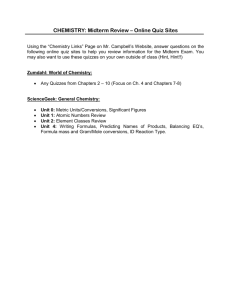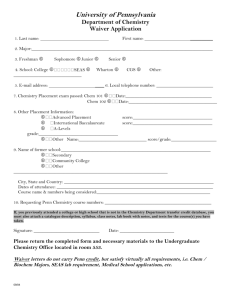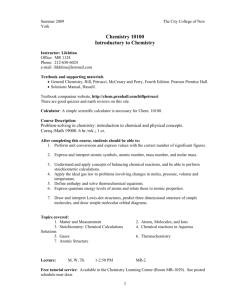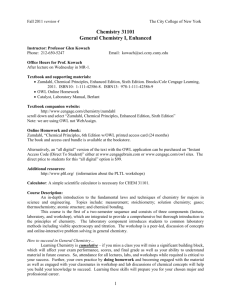Chem 10301, General Chemistry 1
advertisement
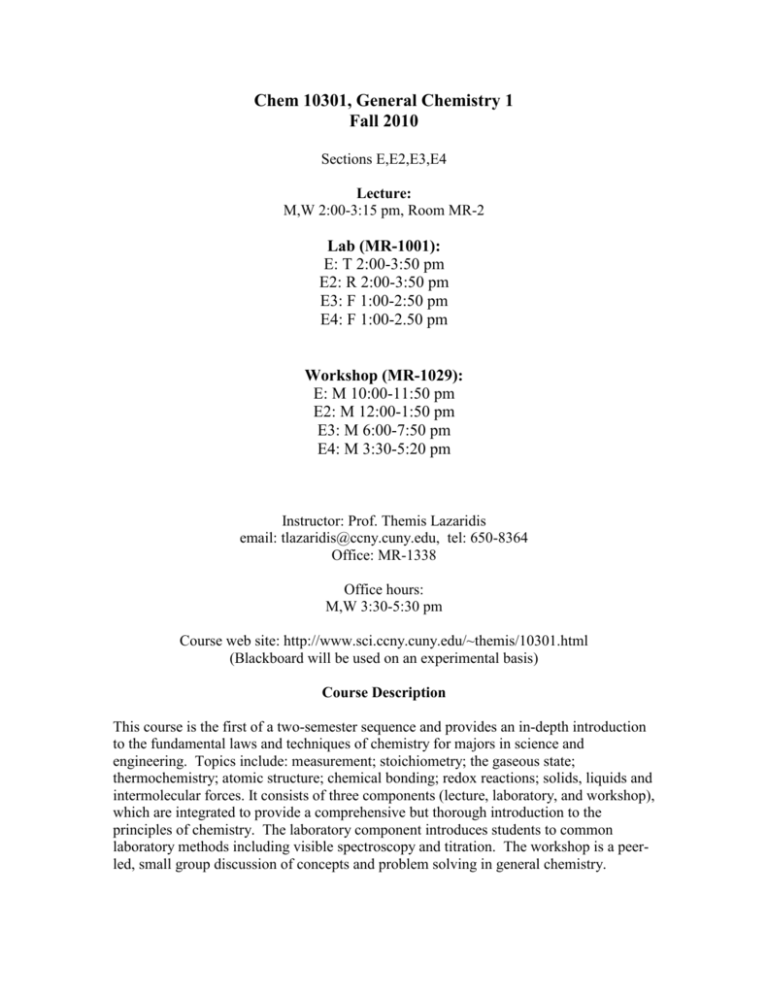
Chem 10301, General Chemistry 1 Fall 2010 Sections E,E2,E3,E4 Lecture: M,W 2:00-3:15 pm, Room MR-2 Lab (MR-1001): E: T 2:00-3:50 pm E2: R 2:00-3:50 pm E3: F 1:00-2:50 pm E4: F 1:00-2.50 pm Workshop (MR-1029): E: M 10:00-11:50 pm E2: M 12:00-1:50 pm E3: M 6:00-7:50 pm E4: M 3:30-5:20 pm Instructor: Prof. Themis Lazaridis email: tlazaridis@ccny.cuny.edu, tel: 650-8364 Office: MR-1338 Office hours: M,W 3:30-5:30 pm Course web site: http://www.sci.ccny.cuny.edu/~themis/10301.html (Blackboard will be used on an experimental basis) Course Description This course is the first of a two-semester sequence and provides an in-depth introduction to the fundamental laws and techniques of chemistry for majors in science and engineering. Topics include: measurement; stoichiometry; the gaseous state; thermochemistry; atomic structure; chemical bonding; redox reactions; solids, liquids and intermolecular forces. It consists of three components (lecture, laboratory, and workshop), which are integrated to provide a comprehensive but thorough introduction to the principles of chemistry. The laboratory component introduces students to common laboratory methods including visible spectroscopy and titration. The workshop is a peerled, small group discussion of concepts and problem solving in general chemistry. Prerequisite: Math 19500 Textbook Julia Burdge, “Chemistry”, 2nd Edition, McGraw-Hill, 2010. Chem 10301 covers the first 11 chapters (except chapter 10). Chem 10401 covers the rest. The bookstore sells two halves of the book separately. You have the option to buy an e-book, for a lower price. Workshop Manual (Gosser et al., 2nd ed.) is sold separately Textbook companion website and online homework: http://www.mharis.com/ In addition to the class code (F33-BA-CCA) you will need a student code which is provided with your book purchased at the CCNY bookstore. If you obtain a book from elsewhere, you have the option to buy a code. One homework will be assigned for each chapter and will be due one week after the last lecture on each chapter. Learning outcomes After completing this course, students should be able to: 1. Perform unit conversions and express values with the correct number of significant figures. 2. Express and interpret atomic symbols, atomic number, mass number, and molar mass. 3. Understand and apply concepts of balancing chemical reactions, and be able to perform stoichiometric calculations. 4. Define enthalpy and solve thermochemical equations. 5. Express quantum energy levels of atoms and relate these to atomic properties. 6. Draw and interpret Lewis-dot structures, predict three dimensional structure of simple molecules, and draw simple molecular orbital diagrams. 7. Apply the ideal gas law to problems involving changes in moles, pressure, volume and temperature. 8. Solve problems involving solution chemistry such as titrations, precipitation, and colligative properties. 9. Write a laboratory report including data and analysis. 10. Be able to conduct a variety of experiments (titrations, spectroscopic) including accurate recording of results and preparation of calibration curves. 11. Be aware and follow the safety requirements in a chemical laboratory. 12. Analyze molecular modeling and graphic plots using computers. 13. Communicate concepts and problem solving of chemistry that have been presented in lecture. 14. Work as part of a problem solving team to solve chemistry problems. 15. Apply chemical principles to selected applications in life science or technology. Exams and grading There will be three midterm exams during the semester and a comprehensive final examination. The lowest grade of the three midterms will be dropped. 40% 35% 15% 10% Midterms: I (Chapters 1-3), II (Chapters 4-5), III (Chapters 6-7) Final Exam (Chapters 1-11 (except 10) cumulative) Laboratory Workshop (based on quizes and online homework) The conversion from points to letter grades is done as follows: 96-100 : 90-95 : 88-89 : 86-87: 82-85: 80-81: A+ A AB+ B B- 77-79: 72-76: 70-71: 60-69: 0-59: C+ C CD F No makeups are offered for the midterm exams. A makeup for the final exam is offered only under compelling circumstances. Tips Learning Chemistry is cumulative – if you miss a class you will miss a significant building block, which will affect your exam performance, scores, and final grade as well as your ability to understand material in future courses. So, attendance for all lectures, labs, and workshops while required is critical to your success. Further, your own practice by doing homework and becoming engaged with the material as well as engaged with your classmates in workshop and lab discussions of chemical concepts will help you build your knowledge to succeed. Learning these skills will prepare you for your chosen major and professional career. You will need a simple scientific calculator for this course. Plan at least three hours of study (reading the chapter and completing the problem sets “homework”) time for every hour you spend in class. Do the problem sets individually (without help from friends or classmates) initially. Please look at a related problem in the solution manual to help you solve the assigned problem. If you are still unable to solve the problem, then ask a friend, classmate, workshop leader, TA, or Professor for help. Attend workshop: finish the Self-Test, finish the workshop problems, and ask questions. Seek help when you have difficulty (office hours, tutoring, study groups with workshop). Free tutorial service Available in the Chemistry Learning Center (MR-1029). Schedule is posted near door. Statement on Academic Integrity The CCNY policy on academic integrity will be followed in this course. The document can be found through the CCNY website by clicking on Current Students → Academic Services → Policy on Academic Integrity. All students must read the details regarding plagiarism and cheating in order to be familiar with the rules of the college. Cases where academic integrity is compromised will be prosecuted according to these rules. In addition, the Policy of Academic Integrity can be found in the Undergraduate Bulletin 2007-2009 in Appendix B.3 on page 312. Tentative lecture schedule 8/30: Introduction/Chapter 1 9/1: Chapter 2 9/8: " 9/13: Chapter 3 9/15: " 9/20: " 9/22: " 9/27: Review/Prep Exam 9/29: 1st Midterm (Ch. 1-3) 10/4: Chapter 4 (O’Brien) 10/6: Demos (M. Razak) 10/13: Chapter 4 (Ceruso) 10/18: Chapter 4 10/20: Chapter 4,5 10/25: Chapter 5 10/27: Chapter 5, review 11/1: Chapter 6 11/3: 2nd Midterm (Ch. 4-5) 11/8: Chapter 6 11/10: “ 11/15: Chapter 7 11/17: Chapter 7 / Review 11/22: Chapter 8 11/24: 3rd Midterm (Ch. 6-7) 11/29: Chapter 8 12/1: Chapter 9 12/6: “ 12/8: Chapter 11 12/13: Review Final Exam: Chapters 1-9 &11 Tentative workshop schedule M 8/30: Unit 1 M 9/13: Unit 2 M 9/20: Unit 3 M 11/1: Unit 7 M 11/8: Over 2nd exam, Unit 8 M 11/15: Unit 9 M 9/27: Unit 4 M 10/4: Over 1st exam M 10/18: Unit 5 M 10/25: Unit 12 M 11/22: Unit 10 M 11/29: Over 3rd exam M 12/6: Unit 11 M 12/13: Unit 6
